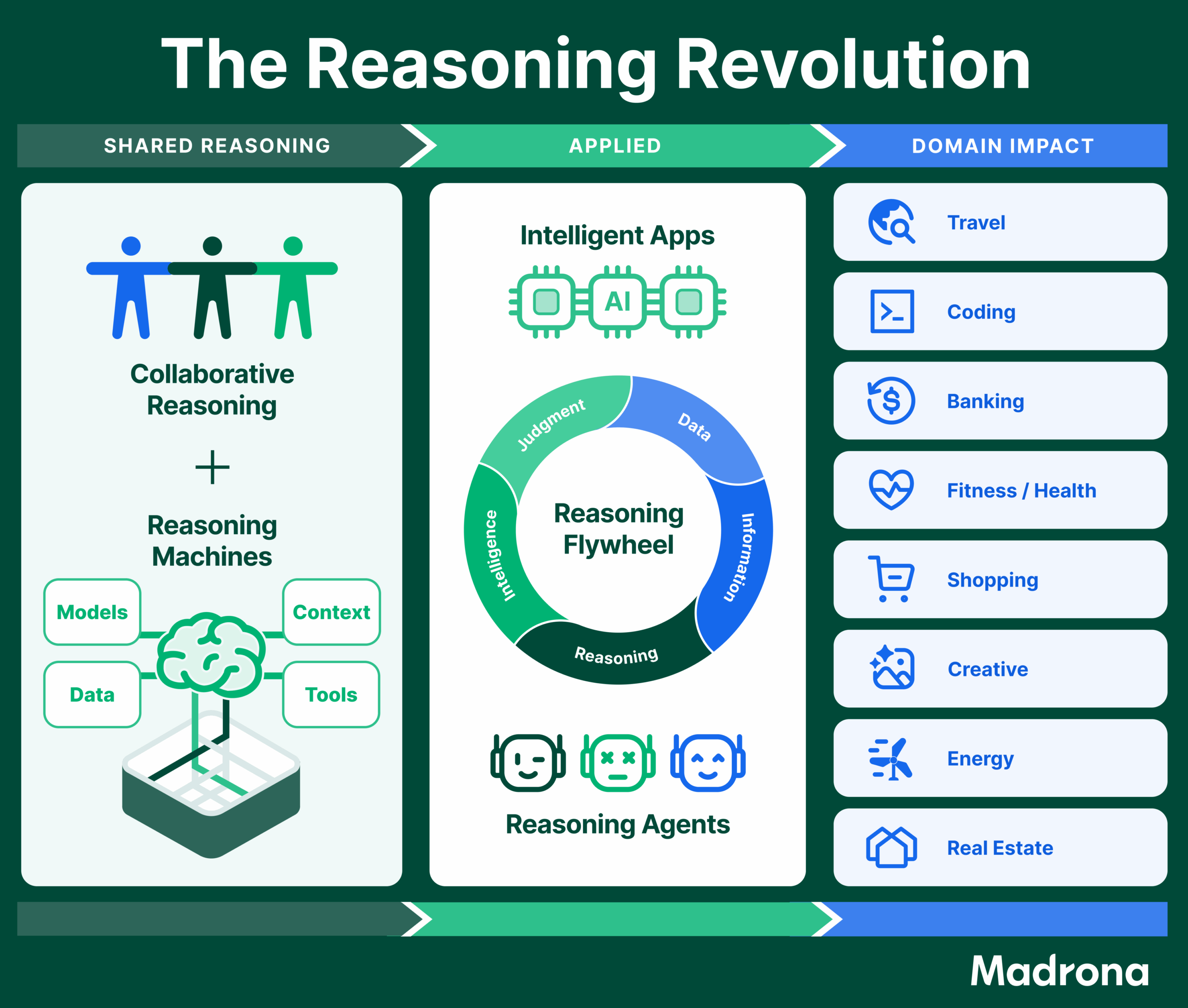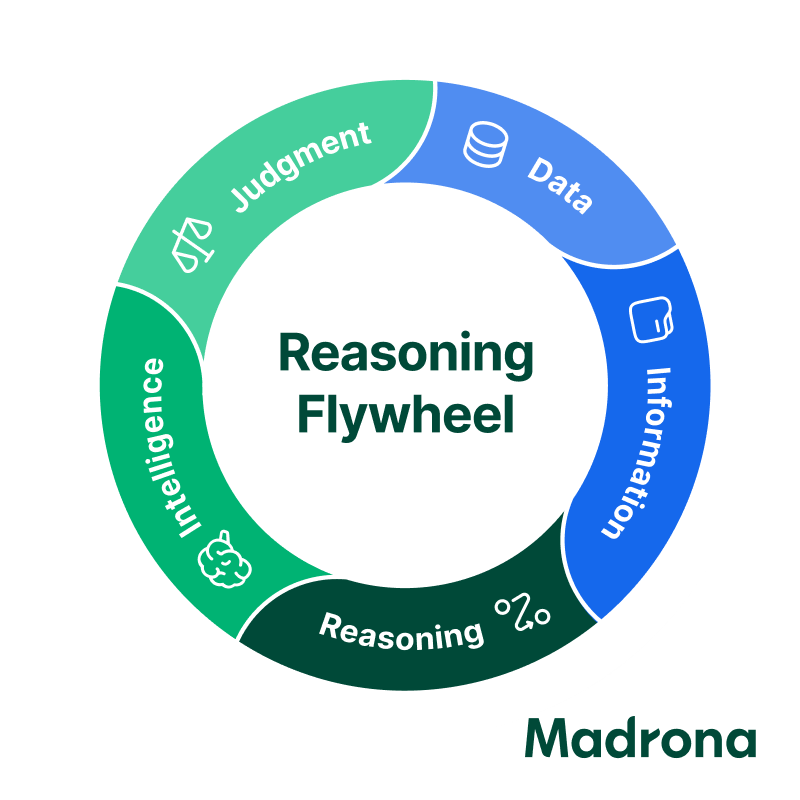We are experiencing the next great innovation era, rivaling the most consequential economic and technological revolutions in history. The pace of this revolution is torrid and will impact all of society in both positive and challenging ways. The opportunity is collaborative reasoning powered by “reasoning machines” and flywheels that enable intelligent applications and reasoning agents. This is the Reasoning Revolution
Reasoning machines, which are intelligent systems beyond AI models, will drive one of the greatest eras of change and opportunity in human history by unlocking the discoveries, insights, and actions made possible by humans and AI machines reasoning together.
Revolutions of this magnitude and pace don’t occur often. Reasoning machines enable both broad and specific solutions to problems humans face. These machines are different from past mechanical and computational machines that enhanced human productivity and quality of life. They combine models, data, context, and tools to create reasoning engines at a scale beyond human capabilities. They enable collaborative reasoning between humans and AI systems that leads to improved decision making and outcomes. Even better, this shared intelligence compounds as each decision creates feedback that generates a reasoning flywheel. As a result, these AI systems have the potential to appreciate in value over time.
I expect the reasoning revolution, enabled by reasoning machines, to transform society and ultimately enhance human capabilities more significantly than how mechanical and electric-powered machines shaped the 19th century industrial revolution and how computational and communication machines enabled the 20th century technological revolution.
Why is the Reasoning Revolution Happening Now?
We live in an age of over-abundant data, information, and perspectives that can paralyze decision making. That’s the problem … and the opportunity. Several forces converged to enable AI models to connect the dots in a world of abundant information and make scalable reasoning feasible:
-
- Data + metadata is largely digitized and can combine structured and unstructured data modalities to pre and post train models.
- Parallel compute has dramatically increased in capacity and capability while rapidly declining in cost per unit (one metric being cost/million tokens).
- Cloud-architected ML/AI infrastructure and services matured for both consumer and enterprise use cases and expanded to work for labeled and unlabeled data types.
- Breakthroughs in model research and productization unlocked interactive, generative, and tool-using systems accessible to developers and builders.
- Continuous advances in pre-training, post-training, and inference-time reasoning are pushing past perceived scaling law ceilings to improve reasoning quality across domains.
Bottom line: The least capable model or reasoning machine you’ll ever use is the one you’re using today! When was the last time you used GPT-3? Unlike each model generation, the well-architected reasoning machines/flywheels can be accretive in value by leveraging customer engagement and reinforcement learning to continually improve.
What are the Big Picture Reasoning Components?
The illustration below highlights how the different components of the reasoning revolution conceptually work together for the combination of human and AI reasoning machines to improve every aspect of life.
The Reasoning Revolution unlocks better decisions and faster actions across every domain. It combines data, context, and AI models to generate scalable reasoning.
Reasoning Machines: AI-powered systems (more than models) that learn patterns, plan, use tools, and decide/recommend are becoming the core engines to support human advancement in the 21st century.
A Reasoning Flywheel aligns humans and machines in collaborative reasoning systems that leverage complementary capabilities and continual reinforcement learning.
Intelligent Applications and Reasoning Agents, both digital and embodied, serve as multimodal interfaces that enable reasoning machines to interact with humans and agents, informing decisions or actions. The applications/agents improve commercial and personal judgement, productivity, and outcomes.
Continuum of Autonomy: Degrees of machine reasoning agency evolve with reliability and trust — what Andrej Karpathy has called partial autonomy. The organization or individual chooses when and how to keep a machine or human in, on, or out of the loop based on capabilities, reliability, perceived risks, and task value creation.
Domain Impact: Each industry or functional domain has differentiated data (open and proprietary; multimodal), vocabulary, legacy systems, and workflows. Reasoning machines will incorporate general and domain-specific capabilities into applied and agentic solutions. Domains impacted vary widely, including coding, travel, banking, marketing, shopping, and many more.
What are Reasoning Machines and Reasoning Flywheels?
A Reasoning Machine is more than an AI model or chatbot. It’s an orchestrated system that:
-
- Understands goals, constraints, and context.
- Plans: decomposes prompts/inputs, selects strategies for research, and routes tasks.
- Uses tools: connectors, enterprise apps, code, content retrieval, and search to provide context and improve output quality.
- Acts safely: drafts, executes workflows, triggers actions with policies and guardrails.
- Self-monitors: explains, tests, verifies, calibrates, and analyzes outputs.
- Learns from outcomes/outputs: incorporates memory and reinforcement learning to improve the machine’s capabilities and the applications/agents they power.
Think of it as a software-defined colleague (an analyst, co-worker, or concierge) built to achieve outcomes, not just produce text. Reasoning machines make decisions and take actions that generate new data, which is the fuel for the next cycle of a reasoning flywheel. That compounding loop, assuming a robust memory and recall structure, is a company or individual’s durable moat for collaborative reasoning.
Reasoning flywheels are anchored by reasoning machines and are emerging in different domain areas. The positive feedback loop that these flywheels create illustrates how intelligence compounds when each decision feeds the next question, and it explains the deeper opportunity for AI systems and people collaborating.
Categories including software development with code editors like Cursor, Windsurf, Github Co-Pilot, Augment, and Claude Code are leading the way in building AI-native, code development product flywheels. While business success across code editing and other categories has varied, the core elements of successful product flywheels are:
-
- Target outcomes: Start with a narrow job-to-be-done with clear metrics and guardrails.
- Establish collaborative reasoning: Train on available data (public, private, synthetic) and models allowing machines to reason and humans to critique/approve exceptions.
- Turn rich feedback into flywheels: use a combination of verification, evaluation, and human/machine reinforcement learning from data responses and actions to measure and refine the underlying models and system as a whole.
- Continually improve the system: Increase data access, continually test and improve models (including custom models), and add external skills and tools that strengthen the system. Expand to adjacencies that increase the context and value of the flywheel.
By building purpose-specific reasoning machines and unlocking their value through intelligent applications and reasoning agents, you can deliver substantial benefits to customers and companies. That value can expand with reasoning flywheels that incorporate engagement data and reinforcement learning into the overall AI-native product. Over time, this product flywheel encourages a broader set of interrelated flywheels for the business: product, internal operations, and external ecosystem flywheels.
The magic of reasoning machines will become more evident as humans and machines work together to unlock latent value. This is where AI stops being a novelty and starts being a professional and personal executive decision-making partner. It’s where AI systems don’t just see or hear your data — they think with it. They synthesize, infer, predict, and recommend based on the totality of your knowledge rather than one silo of information.
Reasoning flywheels are why reasoning machines should appreciate in value, unlike physical and computational machines and even AI models, which all depreciate over time. The distinction between reasoning machines appreciating while AI models depreciate highlights that more economic value will be captured at the application/agentic layer of reasoning flywheels than the model layer in the years ahead.
Intelligent Apps Powered by Reasoning Machines: Cursor
New entrants are challenging incumbent companies by choosing compelling abstraction layers, shipping approachable UX, and building interlocking flywheels. For instance, developer tools like Cursor have emerged as promising challengers to incumbent coding environments by integrating planning, context, and editor workflows — not just better autocomplete. Below is a summary of what I believe is helping Cursor grow market share and engagement (they have work ahead on building a sustainable business model) in the highly competitive developer solutions market.
- Build intelligent applications powered by reasoning flywheels
Cursor built an editor layer that can work with data, workflow, models, and context ACROSS incumbent systems. They found a compelling abstraction layer for their product that interfaces with humans, other applications, and increasingly reasoning agents. They also leveraged other data and workflows to build their reasoning machine. This enabled the flywheel enhanced by data, human expertise, and usage experience (internal usage, partner usage, and end customer usage). - Create a reasoning machine with a model and tools orchestrator layer
Start with open/available models and accessible data to bootstrap the best models and tools from a cost, speed, reliability, and quality output perspective. Those models and tools will continually evolve, and Cursor smartly realized they don’t have to start by building it all themselves. Cursor used different model types and then optimized those models for their use cases with an architecture to interchange models over time. Now, they have built their own models by incorporating product interaction data to build task/domain-specific models. Those models become differentiated options for their orchestration layer to pick from to serve their customers best. - Integrate with other parties/layers in the ecosystem
AI-native companies have a structural advantage to align, share data, and collaboratively improve results with incumbent software companies. As a system of AI execution, Cursor works with the other products customers use today to create more intelligent and intuitive processes across systems of record. This highlights the importance of ecosystem alignment and how Cursor is approaching partnering with others. The other embedded idea here is building trust by embracing the products/processes customers use today and incrementally changing the way they work. After all, human inertia and anxiety are powerful forces, and most transformations don’t happen overnight.
Similar patterns of finding the best abstraction layer, building a reasoning machine/flywheel under that layer, and establishing an ecosystem flywheel are visible in other categories. Examples include Harvey in legal, Decagon and Sierra in customer service, Writer and Gradial in enterprise marketing, and Glean and Read AI in commercial knowledge management. The pattern is what matters most: data + reasoning + workflow + memory + ecosystem beats isolated models and proprietary processes alone.
Navigating the Revolution
Revolutions create opportunity and risk. Even with the capabilities of AI-powered reasoning machines, human nature won’t change, so values, governance, explainability, and accountability matter. Pair bold deployment with strong guardrails, interpretability, auditability, and continuous learning. The prize isn’t AGI; it’s applied, collaborative reasoning that measurably improves outcomes for customers, teams, and society.
The implications are way broader than having the “best model.” It’s about operating Reasoning Machines inside Reasoning Flywheels — systems where humans and machines “co-reason,” act, and learn together.
Here’s the core takeaway for founders building AI-native companies: Focus on the opportunities your target users face today, build an intelligent application or agentic system designed for continuous feedback loops, and construct the reasoning flywheel that turns experience into improved outcomes. Organizations and people that master collaborative reasoning, choose the right abstraction layers, and compound through interlocked flywheels will set the pace — and capture the value — of the Reasoning Revolution.

